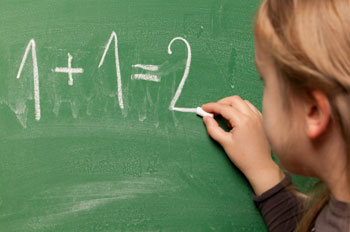7th Grade Math: Percent of Change and Percentages
Solving percentage problems is an important skill that you'll learn in 7th grade. You'll learn to use percentages to calculate tips and taxes, and you'll also learn to calculate the percent of change between two amounts.

Calculating Percent of Change
In percent of change problems, you're usually asked to figure out the percentage that an amount increases or decreases over time. For example, let's imagine that the average temperature last May was 80 degrees, and the average temperature last June was 90 degrees. What percent did the average temperature increase from May to June?
- Find the absolute difference between the two amounts. In this example, 90 degrees - 80 degrees = 10 degrees.
- Determine what percentage of the original amount the difference is. For instance, 10 degrees is 12.5% of 80, since 10/80 x 100 = 12.5.
- Put the answer in the context of the problem. For this problem, the average temperature increased by 12.5% from May to June.
Tip: For percent decrease problems, you follow the same steps. You still report the percent decrease as a positive percentage, but you say that an amount decreased by x percent. The only exception to this rule is when you are displaying information in a table or chart. Since you can't provide a verbal explanation, you represent increases as positive percentages and decreases as negative percentages. For instance, a decrease of 2% would be written as -2% in a table.
Calculating Amount of Change
Some problems will tell you that an amount increased or decreased by a certain percentage. Then, they will ask you to determine the amount that this percentage represents. For instance, imagine that a school had 50 students starting kindergarten last year, but 10% fewer students started kindergarten this year. How many students started kindergarten this year?
- Calculate the specified percentage of the original amount. In this case, you need to find 10% of 50. Since 50 x 10/100 = 500/100 = 5, five is 10% of 50.
- Add or subtract that number to or from the original amount as necessary. In this problem, the number of students decreased by 10%, so you subtract five from 50 to get 45 (50 - 5 = 45). If this were a percent increase problem, you would add to the original amount.
- State your answer in the terms of the problem. For this problem, you would say that 45 students started kindergarten this year.
Percentage Points
Sometimes, you'll be asked how many percentage points something increased or decreased by. For instance, if your science grade was 80% last week, and it's 87% this week, that means your grade increased by seven percentage points because 87 - 80 = 7. However, your grade did not increase by 7%, because the difference between your current grade and last week's grade is not equal to 7% of last week's grade.
Practice Problems
1. Ellen sold 15 tickets for the school dance last week, and this week she sold 30 tickets. By what percentage have her ticket sales increased since last week?
2. The first time Ray took his math test, he got just 40/80 questions correct. After studying some more, Ray retook the test and got 60/80 questions correct. The number of questions he got right increased by what percentage?
3. Last year, 60 students were in the school band, but this year, only 50 students are in it. By what percentage did the number of students in the school band decrease since last year?
Solutions
1. First, calculate the difference between 30 and 15, which is 15 (30 - 15 = 15). Next, divide 15 (the difference in the number of tickets sold) by 15 (the number of tickets sold last week). Since 15/15 = 1, and 1 x 100 = 100, Ellen's ticket sales increased by 100% since last week.
2. The difference in the number of questions Ray got correct between his first test and his second test is 20, since 60 - 40 = 20. To calculate the percent increase, divide 20 by Ray's first score of 40 questions correct to get 0.5 (20/40 = 1/2 = 0.5). The decimal 0.5 x 100 = 50, so the number of questions Ray got correct increased by 50%.
3. The difference in the number of students in the school band between this year and last year is ten, because 60 - 50 = 10. The fraction 10/50 = 1/5 = 0.2, and 0.2 x 100 = 20. This means that the number of students in the school band decreased by 20% between this year and last year.
Other Articles You May Be Interested In
-
MIND Games Lead to Math Gains

Imagine a math teaching tool so effective that it need only be employed twice per week for less than an hour to result in huge proficiency gains. Impossible, you say? Not so...and MIND Research Institute has the virtual penguin to prove it.
-
Should Math Be a Main Focus in Kindergarten?

Should kindergartners put away the building blocks and open the math books? According to recent research, earlier is better when it comes to learning mathematical concepts. But that could put undue pressure on kids, parents and even teachers.
We Found 7 Tutors You Might Be Interested In
Huntington Learning

- What Huntington Learning offers:
- Online and in-center tutoring
- One on one tutoring
- Every Huntington tutor is certified and trained extensively on the most effective teaching methods
K12

- What K12 offers:
- Online tutoring
- Has a strong and effective partnership with public and private schools
- AdvancED-accredited corporation meeting the highest standards of educational management
Kaplan Kids

- What Kaplan Kids offers:
- Online tutoring
- Customized learning plans
- Real-Time Progress Reports track your child's progress
Kumon

- What Kumon offers:
- In-center tutoring
- Individualized programs for your child
- Helps your child develop the skills and study habits needed to improve their academic performance
Sylvan Learning

- What Sylvan Learning offers:
- Online and in-center tutoring
- Sylvan tutors are certified teachers who provide personalized instruction
- Regular assessment and progress reports
Tutor Doctor

- What Tutor Doctor offers:
- In-Home tutoring
- One on one attention by the tutor
- Develops personlized programs by working with your child's existing homework
TutorVista

- What TutorVista offers:
- Online tutoring
- Student works one-on-one with a professional tutor
- Using the virtual whiteboard workspace to share problems, solutions and explanations